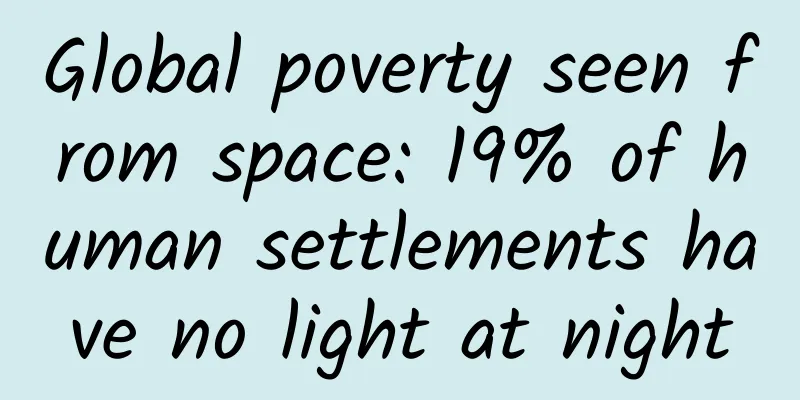Global poverty seen from space: 19% of human settlements have no light at night

|
Despite the great success of global poverty reduction efforts over the past two decades, nearly 1 billion people still lack access to reliable and affordable electricity. The lack of electricity, in turn, has a negative impact on health and the economy, thus hindering the sustainable development of the global human race. Knowing where these poor people are located is crucial if aid and infrastructure are to be delivered to those in need. Recently, a new study led by the International Institute for Applied Systems Analysis (IIASA) proposed a new method to assess the global economic situation using nighttime satellite images. By combining satellite nighttime light images with global human settlement footprint data from 2015, they showed that 19% of the Earth's total settlement footprint has no detectable artificial light. The related research was published in the recent issue of Nature Communications. For nearly 30 years, researchers have been using satellite images of Earth at night to study human activity, particularly in places where regular survey data is lacking. These nighttime lights can help map issues such as economic growth, the scale of poverty and the state of the environment. In developing countries, areas without lights at night usually indicate limited economic development, while brightly lit areas are often metropolitan areas with rich infrastructure. More often, researchers tend to focus on the bright areas on the earth at night, and usually ignore the dark areas in satellite images. But IIASA researchers, along with colleagues from several other institutions, focused specifically on data from unlit areas of the Earth to estimate global economic conditions. "While previous work has focused more on the relationship between lit areas and economic development, we found that it actually works the other way around and that unlit areas are a good indicator of poverty. By identifying those areas without lighting, we can target poverty alleviation interventions and focus areas to improve energy access," explains Steffen Fritz, an author of the paper and project director for IIASA's Strategic Initiatives. (Source: Pixabay) Specifically, the researchers used geospatial-based wealth indices of households in countries across Africa, Asia, and the Americas calculated by the Demographic and Health Surveys (DHS) program. They then combined these data with satellite imagery of global nighttime lights in these countries and found that 19% of the total settlement footprint on Earth has no detectable artificial light. The majority of unlit settlement footprints are in Africa (39%) and Asia (23%). If only rural areas without lighting infrastructure are considered, this figure rises to 65% in Africa and 40% in Asia. And in almost all countries, the results show a clear correlation between an increase in the percentage of unlit areas in a country and a decrease in the level of economic well-being. (Source: Pixabay) "We were able to map and predict the wealth levels of about 2.4 million households in 49 countries across Africa, Asia and the Americas based on the percentage of unlit settlements detected using night-time lights satellite imagery (with an overall accuracy of 87%). Surprisingly, there are also relatively large numbers of unlit settlements in developed countries, especially in Europe. This result could have several reasons, including the fact that the satellite passes are after midnight, but also could be due to strict energy and cost saving policies by European homeowners, governments and industries," said Ian McCallum, head of the Emerging Data Ecosystems for Sustainability research group at IIASA, who led the study. The researchers also note that government agencies often prioritize expanding access to electricity in cities rather than in rural areas. However, rural electrification holds great promise for improving well-being and has significant positive effects on household income, spending, health, and education. The United Nations Sustainable Development Goals (SDGs) specifically include “access to affordable, reliable, sustainable and modern energy for all” and while substantial progress has been made over the past two decades, efforts to achieve this goal come amid signs that governments and industry will struggle to keep up with projected population growth. (Source: Pixabay) In sub-Saharan Africa in particular, projections suggest that more than 300 million people will still be living in extreme poverty by 2030. The impact of the COVID-19 pandemic could push an additional 88 to 115 million people into extreme poverty, delaying the United Nations global poverty alleviation goal by approximately three years. However, new studies like this one may help track electrification in developing countries, as well as light energy consumption in developed countries. “If applied over time, the approach we used in our study could offer an opportunity to track well-being and progress towards the Sustainable Development Goals. On the policy side, it could help better inform global energy policy and also aid remote rural areas that face energy poverty. It could also be useful in developed countries for monitoring aspects such as sustainable lighting and environmental management,” concludes Shonali Pachauri, head of the Transformative Institutions and Social Solutions research group. References: https://www.nature.com/articles/s41467-022-30099-9 https://iiasa.ac.at/news/may-2022/identifying-global-poverty-from-space |
>>: China's Sky Survey Telescope is here! What can it "survey" and how powerful is it?
Recommend
Beijing Intelligent Vehicle Association: 2021 Beijing Autonomous Driving Vehicle Road Test Report
The report shows that as of the end of 2021, a to...
This is the image quality assessment tool used by the TikTok group. Are you sure you don’t want to try it?
Introduction This article starts with the constru...
Make friends with e-commerce academy · Get started with live streaming with zero basics, and learn how to become a live streaming anchor
Make friends with e-commerce academy. Get started...
13 kinds of excellent app designs not only have design aesthetics, but also track user experience
【51CTO.com Quick Translation】We have always been ...
More than 5,000 yuan is gone with just one sip of hot water. How deadly is this sip of hot water?
recently A netizen was in a hurry to go out Drink...
Oral health experts throughout the life cycle suggest eating sugar scientifically and staying away from acidic drinks
Author: Wang Chunxiao Yangyang Chronic Disease Ce...
What should you do if your APP is removed from Apple?
Apple has four methods of punishment: demotion, r...
Online and offline platform traffic diversion methods!
Competition among Internet products is becoming i...
6 elements, how to trick consumers into placing orders step by step?
Our consumption behavior is 100% controlled. Why ...
Romantic attraction or fatal temptation? Who are the night lights affecting subtly?
Artificial light at night can change the behavior...
Leeks, cut and grown again, are a favorite on Chinese tables
Written by Wei Shuihua Header image | TuChong Cre...
The International Space Station will sink into the "Point Nemo" in the South Pacific in 2031. Why was this location chosen?
Do you know what is the largest and most complex ...
Why do people dream?
Dreaming is one of the most wonderful experiences...
3 key points to discuss the strategy of hot-selling products
There are a wide variety of products today, and t...









